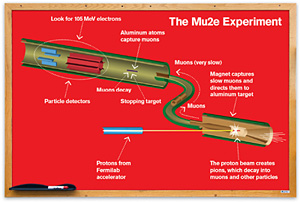
FACT SHEET: Click here to download PDF.
NAME: Muon-to-electron conversion, or Mu2e
WHAT IS THE EXPERIMENT LOOKING FOR? A muon that does not follow the traditional weak-force decay pattern into a lighter electron and two neutrinos, but converts wholly into an electron.
WHAT WILL THIS TELL US ABOUT THE WORLD?
- Observing Mu2e conversion would point the way to a unification of all the forces of nature controlling the interactions of matter. This unification of the four existing forces we observe today — gravity, the electromagnetic force, and the weak and strong forces — is considered Albert Einstein’s dream of “grand unification.
- Finding signs of this “grand unification” could explain how the universe evolved from being dominated by energy and radiation remnants left over from the Big Bang to the universe we see today with visible matter, including planets and people.
- Mu2e could suggest to whether more particles exist in the world and which theories could explain them.
WHY IS THIS EXPERIMENT NEEDED NOW?
- If the LHC finds new particles, it likely will be unable to distinguish how these particles originated without the help of Mu2e adding context to the discoveries. Mu2e would help narrow the number of plausible theories for the origin of these new particles.
- Observing Mu2e conversion points to the existence of new particles. Observing Mu2e above the energy level of the LHC also would give the next generation of colliders an indication of the most promising, discovery-laden energy ranges to search for these particles.
HOW DOES IT WORK? An 8 billion electronvolt, or 8 GeV, proton beam shoots at a fixed target producing a large amount of muons to send to a particle physics detector embedded in a series of superconducting magnets. The magnets are designed to direct a low-energy muon beam that can be stopped in a thin aluminum target. The magnets also provide a constant magnetic field in the detector region that allows the momentum of the conversion electrons to be accurately determined. Physicists can track whether the muons change into electrons.
FUNDED BY: DOE
NUMBER OF COLLABORATORS: Seven
U.S. COLLABORATING INSTITUTIONS: 12 universities, three national laboratories and one company
NON-US COLLABORATING INSTITUTIONS: Three national laboratories in Italy and Russia
WHAT EXPERIMENTS DOES IT BUILD ON: SINDRUM II
WHAT MAKES THE EXPERIMENT UNIQUE? Previous experiments have looked at about ten trillion muons; Fermilab's Mu2e experiment will observe 10,000 times more data.
HOW DOES THIS FIT INTO FERMILAB’S STRATEGIC PLAN? It would require minor changes to the Fermilab accelerator complex and position the laboratory as a leader in ultra-rare flavor physics on the Intensity Frontier. With an upgrade, using the Project X accelerator, Mu2e could expand its search for charged lepton conversion and other new physics by two orders of magnitude.
STATUS: Research & Development are underway. DOE review for Critical Decision-1, which determines design alternatives and a cost range for the experiment, is expected in 2011. Earliest construction could begin 2013 with data-taking beginning in 2017.
LIFESPAN OF EXPERIMENT: Two years, then possible upgrade
PHYSICS FRONTIER EXPLORING: It directly probes the Intensity Frontier and aids research on the Energy and Cosmic frontiers with precision measurements to characterize the properties and interactions of new particles.
FUN FACTS:
- Seeing muon-to-electron conversion will be more difficult than finding a needle in a haystack and will require patience and vast quantities of muons. In fact, theorists predict that this type of conversion happens so rarely that observing it would equate to finding one penny with a unique scratch on Abraham Lincoln’s head. That penny would be hidden in one of 234 piles of pristine pennies with each pile amounting to the 2010 U.S. budget of $3.55 trillion.
- Mu2e will have enough sensitivity to see a muon transform to an electron even if that only occurs in one out of 100 million billion muons.
- Mu2e can search far beyond the reach of the LHC — up to the energy scale of 10,000 trillion electronvolts, or 10,000 TeV. The LHC has an energy goal of 14 TeV.
- During the experiment's projected two-year running period, roughly 50 billion muons per second will be stopped.
- The addition of Project X could extend the initial experiment's sensitivity by a factor of 100. This is comparable to Mu2e initially producing a number of muons equivalent to 1 percent of the grains of the grains of sand on Earth and with the aid of Project X, producing enough muons to equal all the grains of sand.
ADDITIONAL INFORMATION:
Website for the public about Mu2e: http://dev.xenomedia.com:22082/index.shtml
Website for physicists abut Mu2e: http://mu2e.fnal.gov/public/hep/index.shtml